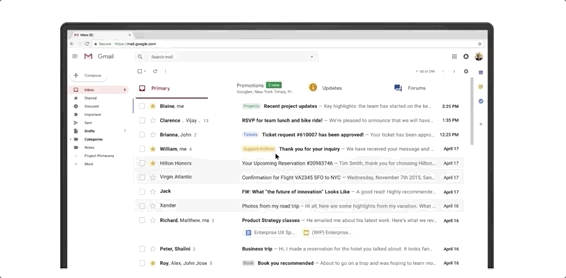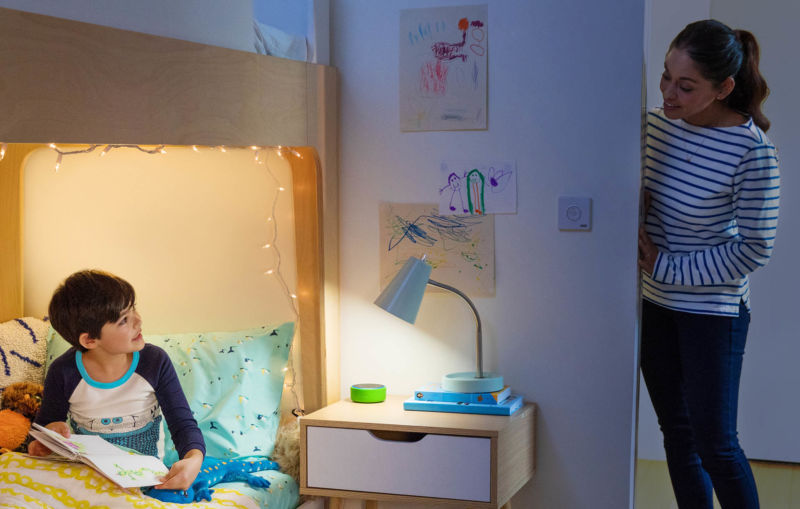Technology - Google News |
- Gmail's biggest redesign is now live
- Amazon made an Echo Dot for kids, and it costs $30 more than the original
- BMW debuts iX3 SUV electric car
| Gmail's biggest redesign is now live Posted: 25 Apr 2018 12:00 AM PDT The world's most popular email service is getting a big overhaul today. Google is making official the changes we saw leaked earlier this month, with email snoozing, nudging, and confidential mode making their debut alongside a substantial visual redesign for Gmail on the web. The new Gmail begins a global phased rollout today, which is to say that it won't be available to every one of Gmail's 1.4 billion users right away, and the first to get it will be invited to opt in rather than being able to just turn it on themselves. Speaking with The Verge ahead of today's launch, Jacob Bank, lead product manager for Gmail, says that Google's redesign was done with an eye on "making people safer and more productive." Those sound like the priorities of business users, and there's a distinct sense among the series of changes Google has made that we're all going to be treated a lot more like Google's business customers. Which is no bad thing.  The safety pillar centers around a new confidential mode. This allows the sender to set an expiration date for a sensitive email or to revoke it entirely. Google makes it work by not sending the confidential content directly — you're only sending a link to the content, which lives in your mailbox and is accessed by the recipient either via their Gmail account or, if they use another email service, https. In both cases, you, the sender, are in charge of how long the other party can access the message. You're basically handing out a time-limited access license. Integrated rights management (IRM) is one of a number of business-centric features making it into the new Gmail for everyone, allowing you to block the forwarding, copying, downloading, or printing of particular messages. It's obviously not going to prevent deliberate data extraction from such emails, but Google believes there's a wide range of circumstances where people accidentally or unwittingly share information with the wrong person, and that's the problem the company hopes to ameliorate. Two-factor authentication (2FA) on a per-message basis is also being added in under the umbrella of confidential mode. You can request that the recipient authenticate with a passcode received via text message before they're able to open a confidential email. Alas, as big a change as confidential mode and its ancillary IRM and 2FA facets are for the new Gmail, it seems like they won't be ready straight away, with Google promising we'll be able to start using the secure mode "in the coming weeks." /cdn.vox-cdn.com/uploads/chorus_asset/file/10713201/SecurityWarning_02.png) Google is also touting some of the results of a behind-the-scenes security redesign focused on preventing phishing scams. "We've increased our investment in phishing protection dramatically," says Bank, explaining that Google's machine-learning algorithms are running safety checks on every new message received. In terms of user-facing visuals, Google is ramping up its phishing warnings from basic banners to huge color-coded alerts. There's now an unmissable call to action for the user when Gmail detects a potentially malicious or fraudulent message.  Email snoozing is now a common feature among third-party email clients, and Google has done the obvious thing by integrating it directly into Gmail. It works nicely with a new hover menu that surfaces the most common interactions you might want with an email — archive, delete, mark as read, or snooze for later — as you place your cursor above each message in your inbox. It makes Gmail on the web look and feel a lot more like an app, though there's no word as to whether the change might also show up in the mobile Gmail apps. Another neat addition to the web version is the ability to tap into email attachments directly from the inbox without opening up the conversation. Google goes a step further by adding what it calls nudging of emails, resurfacing the ones that it recognizes require a time-sensitive action or response. "We don't nudge very often," points out Bank, "but when we do, it can save people from making a high-cost mistake." To determine which messages require your attention, Google looks at a bunch of signals like who sent you an email and whether it has certain content. Queried about the privacy of this new feature, Bank explains that "it shares a lot of the same machinery" as Google's Smart Reply options, which are now coming to Gmail on the web. /cdn.vox-cdn.com/uploads/chorus_asset/file/10713205/Nudging.png) Snoozing, smart reply, attachments tappable from the inbox: these were all features that were already available in Google's Inbox app. In a slight shift from how Inbox was characterized at launch, Bank says it now amounts to an experimental test bed for future Gmail features. "Inbox is the next-gen, early adopter version, whereas Gmail is the flagship that will eventually get the best new features," according to Bank. "We don't want to make changes frivolously, or with a lot of risk, with Gmail." Google isn't removing any Gmail features in this redesign, it's all addition by addition. Among a smattering of visual updates, the biggest functional UI change to Gmail on the web might be the addition of a new collapsible right-hand side panel. This aims to better integrate Google's G Suite apps, with Google Calendar, Google Keep, and a new Google Tasks all finding a new home there. The side panel will let you organize meetings, plan out your day, or just scribble down a few notes without leaving an email to go into another tab or another app. A corresponding Google Tasks mobile app is being released on both iOS and Android today.  Also a first for Google's web interface will be the ability to collapse the left-side panel that hosts the usual navigation links and thus open up more horizontal space. "We have a bifurcated user base," notes Bank. "The vast majority prefer a more comfortable display, but a small but vocal minority just wants to see as many emails as possible." To satisfy both groups, one of the first settings Google will prompt new users to decide on is the vertical display density of their inbox. There are still only three settings: default, comfortable, and compact. Also by popular request, Google has built a robust native offline mode. Users, especially business users who travel a lot, "want to be able to take their standard Gmail tab offline and work in the same UI," says Bank. That's what Google is giving them, though the reason it took so long to get there was not trivial. According to the Gmail product manager, "a rewrite of the entire technical stack of Gmail was required to make this possible." /cdn.vox-cdn.com/uploads/chorus_asset/file/10713313/HighPriorityAndUnsubscribe__1_.png) While the majority of Google's overhaul is focused on Gmail on the web, the mobile apps are also getting an important change with the introduction of high-priority notifications. Already available in the mobile Inbox app, this is a feature where Google uses its AI systems to intelligently select which emails you'll want to be notified about and which you can afford to look at later. According to Bank, this change has "cut 97 percent of email notifications for [Google's] users." That indicates it's an ambitiously aggressive notification filter, and Google's now apparently confident enough to offer it to everyone. Also helpful is the addition of a one-tap unsubscribe prompt in the mobile apps for things like newsletters you may have signed up for but haven't read in weeks. Taken as a whole, this is obviously the biggest set of changes that Google has ever made to Gmail in one fell swoop. The company has been cautious about alienating its enormous and enormously varied user base, and its alterations appear to be a collection of obvious / overdue improvements and logical extensions of the familiar Gmail service. The new look, which exhibits a lot of softer forms and pill-shaped buttons, will have to prove itself over time, but the new features already look like a promising change for the better. |
| Amazon made an Echo Dot for kids, and it costs $30 more than the original Posted: 25 Apr 2018 07:37 AM PDT  Amazon Those with an Amazon Echo device in their home have likely already exposed their children to Alexa. Now, Amazon wants to give kids the opportunity to turn Alexa into their friend with the new Echo Dot Kids Edition. The hockey puck-like smart speaker doesn't look much different than the original Dot, but it comes with new "Amazon FreeTIme" content that gives kids new ways to interact with Alexa and parents more control over over those interactions. The $79 Echo Dot Kids Edition takes the original device's design and wraps it in a kid-friendly, colorful case. Otherwise, the hardware is the same as the tiny smart speaker that debuted in 2016. While the regular, $49 Dot is considered a more affordable and accessible version of the regular Echo speaker, the Kids Edition costs more thanks to its bundled software. Amazon includes a two-year warranty plus a one-year subscription to the new Amazon FreeTime Unlimited service, an expanded version of Amazon's new FreeTime. FreeTime gives users "family-focused features" and new parental controls that adults can use to restrict what their kids can do with Alexa. Family features include "Education Q&A," allowing kids to ask Alexa science, math, spelling, and definition questions, "Alexa Speaks 'Kid,'" which gives Alexa kid-appropriate answers to nebulous statements that kids may say such as, "Alexa, I'm bored." Parents can also limit the times during which kids can speak to Alexa (like no talking to it after bedtime), restrict the skills kids can use, filter out songs with explicit lyrics, and more. All of those features and more with FreeTime will be available for free for Echo, Echo Dot, and Echo Plus users through an OTA update that's coming on May 9. Amazon's FreeTime Unlimited builds upon those free features with exclusive content that Prime members can pay $2.99 per month to access. FreeTime is geared towards kids so most content is family-friendly, including 300 Audible books that Alexa can read to children, ad-free stations and playlists from iHeartRadio that are also kid-friendly, and "premium skills" from partners including Disney and Nickelodeon that offer more ways that children can interact with Alexa. Alexa, kids, and privacyAmazon isn't new to making devices for kids. The company already makes kid-friendly Fire tablets that give parents more affordable and durable alternatives to iPads. Introducing an Echo for kids makes sense considering the growing popularity of Alexa in the home and the likelihood that many kids have already been exposed to Alexa thanks to smart speakers their parents have purchased. Plenty of kid-focused skills exist in the vast Alexa skills library already, but offering more children's content gives both parents and kids new motivation to bring Alexa into their homes. While kids will likely be excited for Disney-provided stories and National Geographic voice games, parents will be happy that they will soon be able to restrict their children's access to Alexa. Consumers have been pushing for better parental controls across many platforms, like iOS and iPhone. But even with the added parental controls, some will be wary of a speaker designed to listen to their children. Like the original Dot, the Kids Edition has a mute button and parents can put the device in "sleep mode" to prevent it from responding to commands. However, the mic will always be listening for its wake-word just like other Echo devices. In the new Parent Dashboard in the Alexa app and online, parents can monitor how kids are using their Echos (including all their utterances, or the phrases Alexa thinks it heard before trying to respond) and limit their abilities. According to a Buzzfeed report, Amazon claims it isn't making back-end profiles for users with data harvested from Alexa. While the virtual assistant can now recognize voices and provide personalized answers based on who's talking, the company maintains that data is only being used to make Alexa smarter and more tailored to each user. That's an important distinction to make considering the problems Facebook and Google have dealt with recently. Amazon continues to push the idea that the company isn't interested in using Alexa-collected user data for marketing purposes. As for skills developers, Amazon claims it only shares "what they need to execute on the skills." Even so, some will still be concerned about placing an always-listening speaker in their kids' bedroom. The new Echo Dot Kids Edition will begin shipping on May 9. |
| BMW debuts iX3 SUV electric car Posted: 25 Apr 2018 07:01 AM PDT  The iX3 SUV, revealed in Beijing today, brings BMW into the mainstream when it comes to electric cars. No longer will BMW electrics be specialized models that look like science experiments, made of space-age carbon fiber or riding on skinny tires for the ultimate efficiency. Instead, the company will revert to building electric versions of its mainstream models, similarly to what it did with the Active-E, based on the original 2-series coupe. The iX3 represents the first of those models from BMW. As we reported on Monday, the iX3 will be based on BMW's very conventional X3 SUV, with an electric drive system under the hood and batteries spread under the floor. The iX3 uses the company's fifth-generation electric car architecture, designed to be lighter and more compact than its previous electric power systems, to give it flexibility to fit into a wider variety of mainstream vehicles, including front-, rear-, and all-wheel drive. The new electric motor develops 270 horsepower, and a 70-kwh lithium-ion battery pack gives the iX3 a range of 249 miles on the world driving cycle. That number will probably be less on the U.S. EPA cycle. It can charge at up to 150 kw, at any of the new fast-which will refill 80 percent of the battery charge in 30 minutes, at any of the new Electrify America charging stations rolling out across the U.S. Otherwise the iX3 is a standard i3 SUV with a similar design treatment to other BMW electrics and electric concepts, with closed-off grille kidneys, blue accents, and more aerodynamic wheels. BMW confirmed in a press release that the electric powertrain components will be built at its U.S. factory in Spartanburg, S.C., as well as in Germany and China. Since X3s are already built in the U.S., that could indicate that the car will likely be sold in the U.S. |
| You are subscribed to email updates from Technology - Google News. To stop receiving these emails, you may unsubscribe now. | Email delivery powered by Google |
| Google, 1600 Amphitheatre Parkway, Mountain View, CA 94043, United States | |
This post have 0 komentar
EmoticonEmoticon